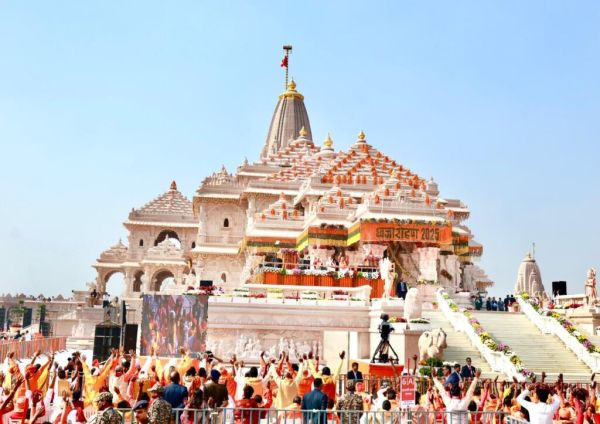
Sandy Verma
Tezzbuzz|25-11-2025
Ayodhya today stands at the crossroads, where the spiritual dignity of the first Puri among the Sapta Puris and the needs of the modern city of the twenty-first century are taking a new shape. Under the leadership of Chief Minister Yogi Adityanath, a holistic and long-term plan is underway to develop it as a global spiritual-tourism center under Vision-2031, in which connectivity, clean-beautiful infrastructure, cultural preservation and technology-based services are being shaped through eight major dimensions.
The first dimension is – accessible Ayodhya. Maharishi Valmiki International Airport, spread over approximately 821 acres, is ready to handle large aircraft with a 2200 meter long runway and state-of-the-art navigation system and expansion work is underway in further phases, thereby fully opening up the airways for crores of devotees. Ayodhya Dham railway station has been transformed into a G+2 building, 6 platforms and a modern terminal with a capacity of about 50,000 passengers, where premium trains like Amrit Bharat and Vande Bharat also stop. [attached_file:file:1] Within the city, projects like Ram Path, Bhakti Path, Shri Ram Janmabhoomi Path and the four-lane Dharam Path have made the journey from Sahadatganj to Nayaghat and Lata Mangeshkar Chowk to Lucknow-Gorakhpur Marg more accessible and experiential with widened pathways, utility ducts, bus bays, walkways, vintage lighting and wall murals decorated with Ramayana themes.
The second dimension is – modern Ayodhya. The GIS based Master Plan – 2031 prepared for 133 square kilometer area is being linked to the online building map passing system, thereby strengthening the foundation of planned urbanization. Under the state smart city scheme, red light violation detection and adaptive traffic control systems are being installed at 22 major intersections, while public address systems in municipal corporation areas and WiFi zones at Hanumangarhi, Nayaghat, railway stations and Guptar Ghat are creating a safe and digital-friendly environment for visitors. The initiative of the experience center providing virtual Ramayana Katha and Ayodhya Darshan through AR/VR based 3D metaverse indicates that this traditional pilgrimage is also assimilating new technology.
The third dimension focuses on realizing the vision of Clean Ayodhya, Clean Saryu and Clean Streets. Sewage management is being scaled up to meet the future population by adding 6 MLD additional capacity to the 12 MLD STP at Ramghat, while water supply, drainage, road and drain construction works have been completed in 181 streets of 15 wards. Five public toilet-utility centres, sterilization of dogs under Animal Birth Control and stray animal management, along with renovation of 10 traditional cremation chambers, construction of 2 electric and 2 green cremation chambers are an attempt to strike a balance between faith and environmental protection.
The fourth dimension is picturesque Ayodhya. Development of 24 meter wide road, parking, kiosks and public leisure spaces at Guptar Ghat has emerged as the new hub of water tourism, water sports and adventure activities, while beautification of Ram Ki Paidi and Naya Ghat with 32 stone chhatris, 11 pillars and 60 interpretation walls is giving divine look to the Saryu bank. The elevated backlight ‘Ayodhya logo’ across the city, 12 corten steel sculptures of vehicles of the deities and facade lighting on Dashrath Mahal, Suryakund etc. along with 15,000 saplings at 75 sites and development of Miyawaki Forest have given a new visual language to the brand identity of Ayodhya.
The fifth dimension, Cultural Ayodhya, emphasizes the preservation of folk beliefs and Sanatan heritage of the Ramayana period. Selected historical sites are undergoing revival through surface improvements and murals, while 162 murals on 81 walls under the Shri Ram Heritage Walk provide a continuous glimpse of Ramkatha to the devotees. Grand entrance of Dharma Path, mirror table based on Ramayana theme, restoration of Queen Ho Memorial Park dedicated to Queen Heo Hwang-Ok of Korea, beautification of Ramkatha Park and Ayodhya Research Institute. The process of upgrading Ayodhya as an international Ramayana and Vedic research institute is establishing Ayodhya in the global cultural context.
The sixth dimension is spiritual Ayodhya. The development of rest houses, toilets, drinking water, food outlets and entrance gates at 24 major places on the Panchkosi and fourteen Kosi Parikrama routes is increasing the convenience of the pilgrims, while the infrastructure has been strengthened by declaring 84 Kosi Parikrama routes as National Highways. 84 Development of 8 major ponds including Dasharatha Samadhi Sthal, Bharat Kund, Janamjeya Kund associated with Kosi Parikrama and conservation of Sant Ravidas Temple complex also strengthens the message of social harmony along with spirituality.
Under the seventh dimension, Saksham Ayodhya, construction of 20 suite rooms and meeting hall with capacity of 60–70 people along NH-28, renovation of 49 schools, reconstruction of four composite schools and establishment of ITI are laying the foundation for future human capital and administrative capacity. The Arundhati Parking-Commercial Complex has 36 shops, offices, 240 car parking, 180-bed dormitory, food court and online parking system giving structure to the tourism-based economy.
The eighth dimension is Ayushman Ayodhya. Construction of educational building and OPD block in the Government Ayurvedic Hospital, establishment of Rajarshi Dashrath Autonomous Medical College, 100 bedded hospitals in Kumarganj and 50 bedded hospitals in Milkipur are becoming a new assurance of health security not only for the local citizens but also for lakhs of devotees. With these eight dimensions, Ayodhya is emerging as a model city where heritage and development both seem to breathe together.

“Virat should have left ODIs & continued playing Test cricket”: India’s flop show in Guwahati leads to big claim

IND vs SA 2nd Test: Markram-Rickelton Stitch Another 50-Run Stand, India's Dry Spell Continues

Ravindra Jadeja Still in ODI Plans, Star Pacer Ignored Again; 3 Major Takeaways From India Squad for South Africa ODIs

Sherfane Rutherford hammers his seventh ODI fifty: Key stats






